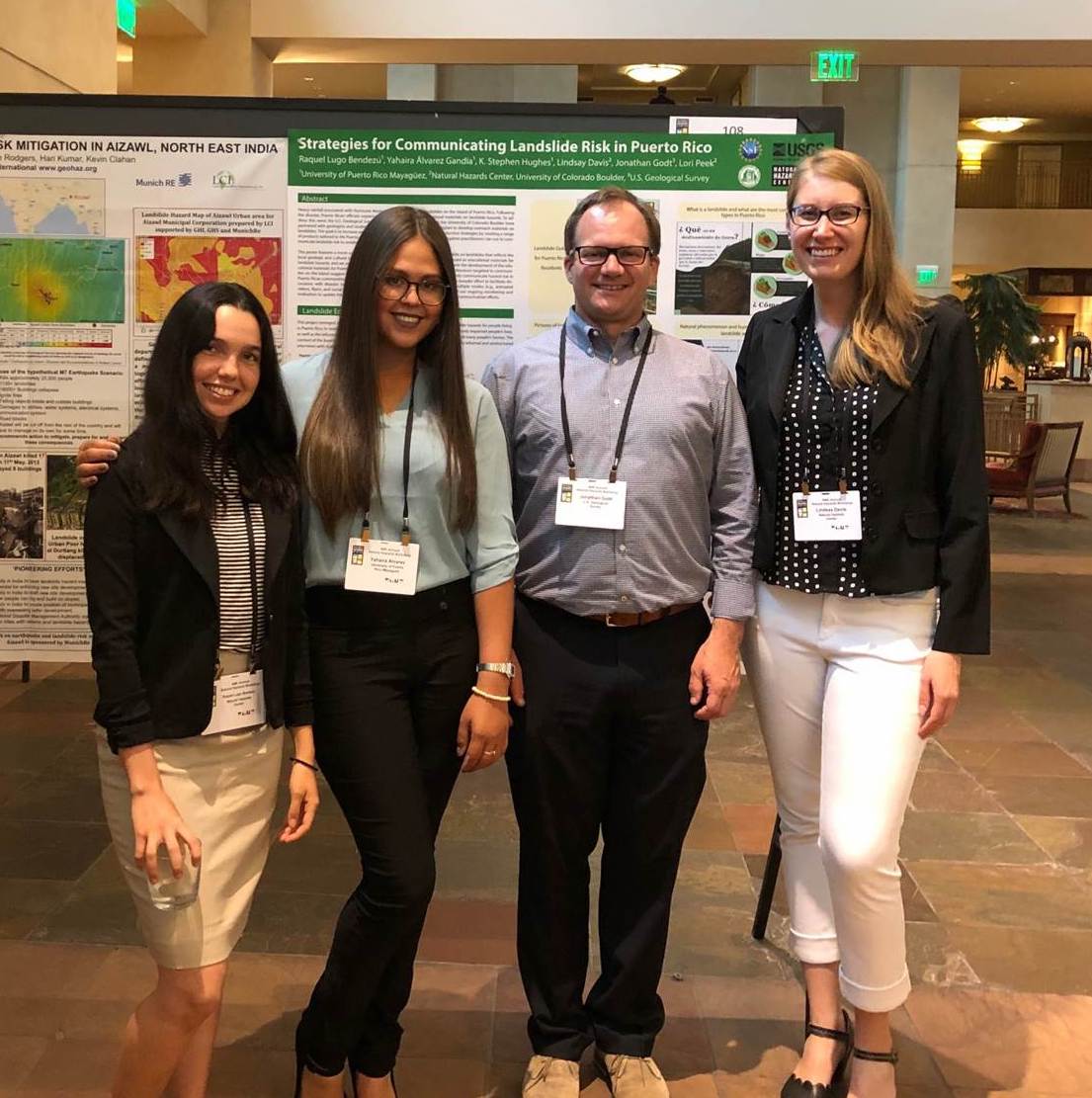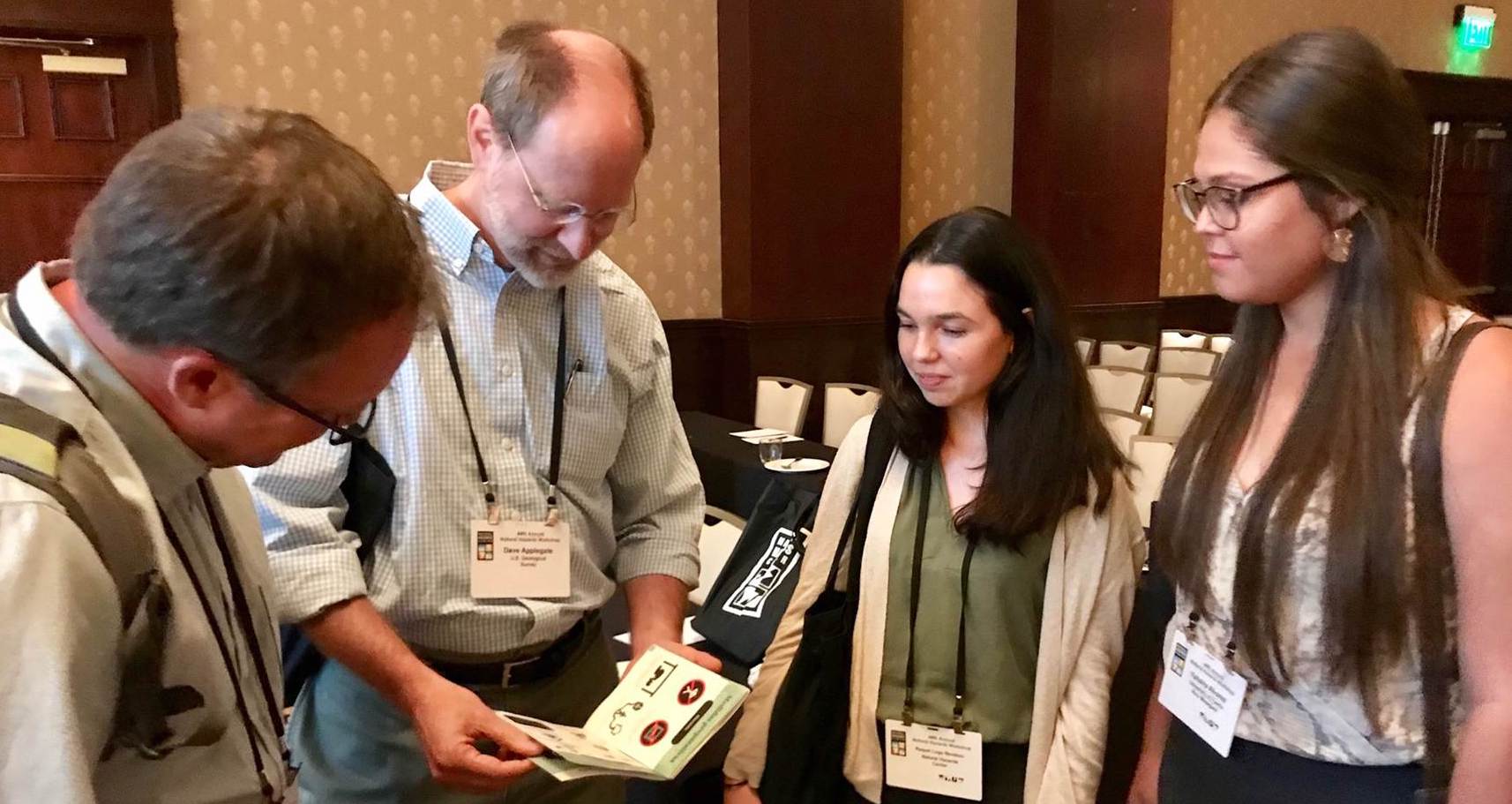 Landslide activity after Hurricane Maria. ©Lindsay Davis, 2018.
Landslide activity after Hurricane Maria. ©Lindsay Davis, 2018.
Raquel Lugo Bendezú and Yahaira D. Álvarez Gandía, both geology students at the University of Puerto Rico Mayagüez, joined the Natural Hazards Center team as Undergraduate Research Assistants in January for the 2019 calendar year. The students are collaborating on an ongoing landslide risk reduction project coordinated by the U.S. Geological Survey (USGS) and the Natural Hazards Center to support organizations, universities, agencies, municipalities, and residents in Puerto Rico to reduce landslide risk and promote resilience throughout the island.
 UPR Mayagüez undergraduate research assistants, Raquel Lugo Bendezú and Yahaira D. Álvarez Gandía, pictured with Jonathan Godt of the U.S. Geological Survey and Lindsay Davis of the Natural Hazards Center at the poster session at the 44th annual Natural Hazards Workshop. ©Lindsay Davis, 2019.
UPR Mayagüez undergraduate research assistants, Raquel Lugo Bendezú and Yahaira D. Álvarez Gandía, pictured with Jonathan Godt of the U.S. Geological Survey and Lindsay Davis of the Natural Hazards Center at the poster session at the 44th annual Natural Hazards Workshop. ©Lindsay Davis, 2019.
“Working on the landslide hazard project has been one of the best professional experiences I have had,” Álvarez said. “This project will raise awareness about landslide risk on the island, which was one of the most prevalent phenomena after the passing of Hurricane María. I hope that in the future this work will help save lives.”
Ongoing USGS work with local counterparts in Puerto Rico provided the platform for this work. These materials will complement a variety of technical landslide products currently in development for the island by USGS and the University of Puerto Rico Mayagüez. Stephen Hughes, of the University of Puerto Rico Mayagüez, and Lindsay Davis, a research associate at the Natural Hazards Center who works closely with USGS, are co-supervising the students as they create landslide education and outreach materials for the residents of Puerto Rico.
Both students are passionate about learning new design techniques as part of risk communication. The pair have been working on the graphic design and Spanish-language content for a landslide guide that will serve as the first piece of a multi-faceted educational campaign to reduce landslide risk in Puerto Rico. Once the guide is complete, the students will translate the information and graphics into various formats in order to target specific audiences. For example, the team learned from local partners that social media is an appropriate and widely accessible avenue to reach youth on the island, while channels such as television, radio, or community meetings may be more appropriate to target decisionmakers, emergency managers, and mitigation professionals.
“It has been a great opportunity working on this project,” Lugo stated. “We are constantly thinking of ways to make the content more engaging and useful for everyone. I have seen the damaging effects that landslides have had on people's homes and lives, and this project will put a spotlight on a natural hazard we do not usually think will affect us.”
While different options for information sharing are still being explored, educational institutions and agencies that work directly with communities such as the National Weather Service, the Puerto Rico Seismic Network, and the Caribbean Tsunami Warning Program have expressed interest in collaborating on the dissemination of landslide risk reduction materials once they are complete. The common goal: use science and education to reduce the risk of landslide hazards on the island of Puerto Rico.
 UPR Mayagüez undergraduate research assistants, Raquel Lugo Bendezú and Yahaira D. Álvarez Gandía, share Spanish-language landslide education materials with Jonathan Godt and David Applegate of the U.S. Geological Survey at the 44th annual Natural Hazards Workshop. ©Lindsay Davis, 2019
UPR Mayagüez undergraduate research assistants, Raquel Lugo Bendezú and Yahaira D. Álvarez Gandía, share Spanish-language landslide education materials with Jonathan Godt and David Applegate of the U.S. Geological Survey at the 44th annual Natural Hazards Workshop. ©Lindsay Davis, 2019